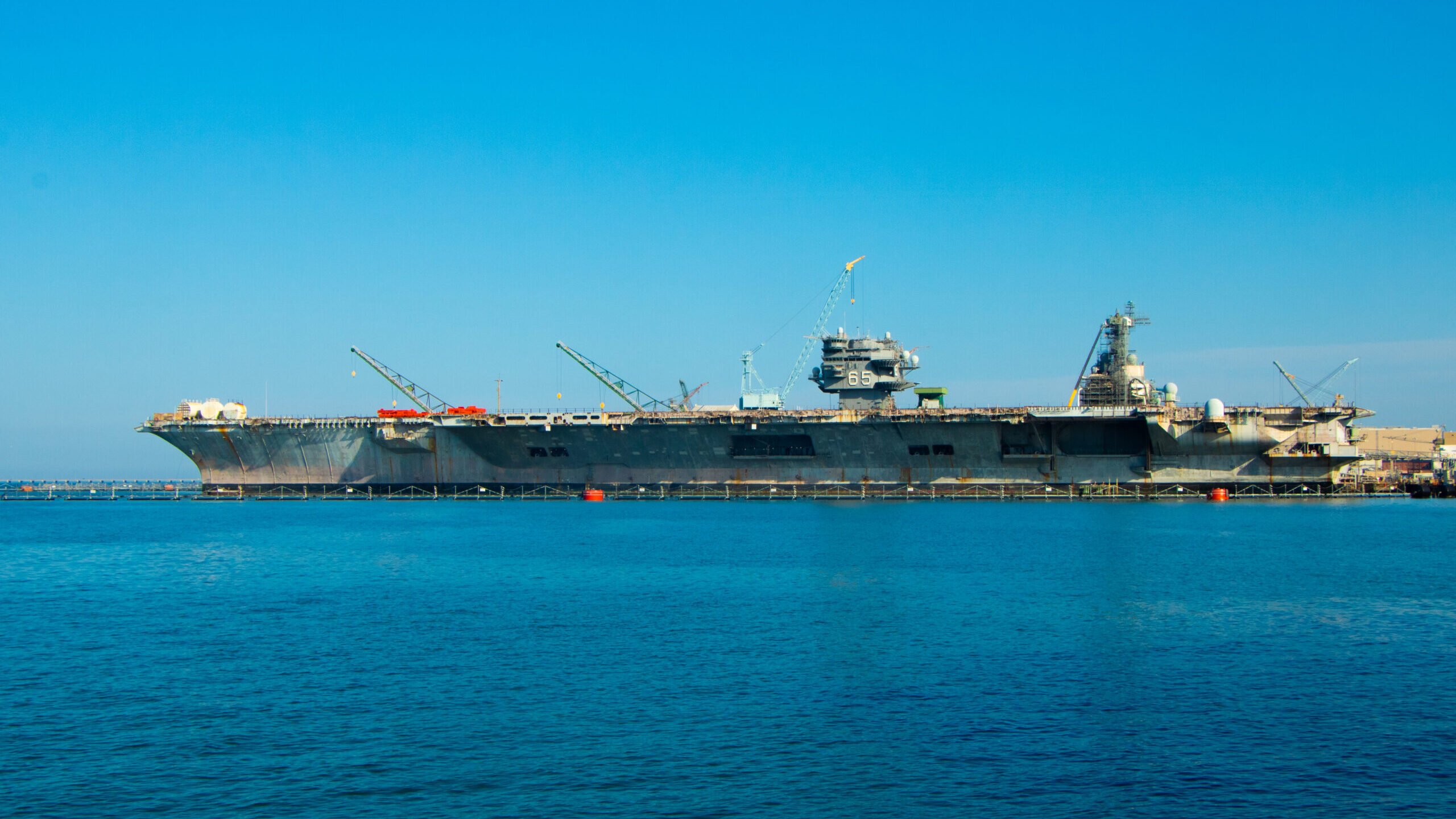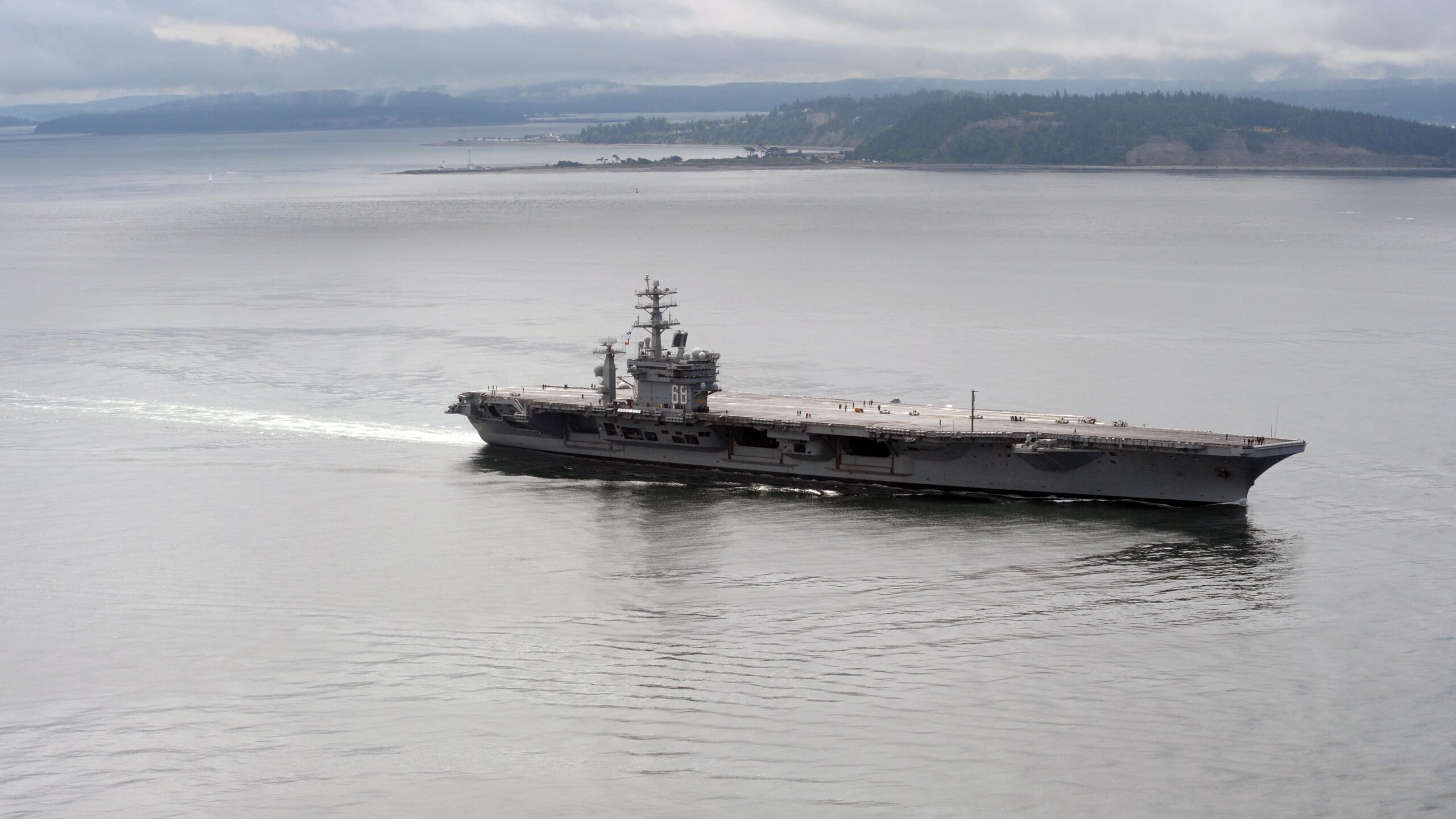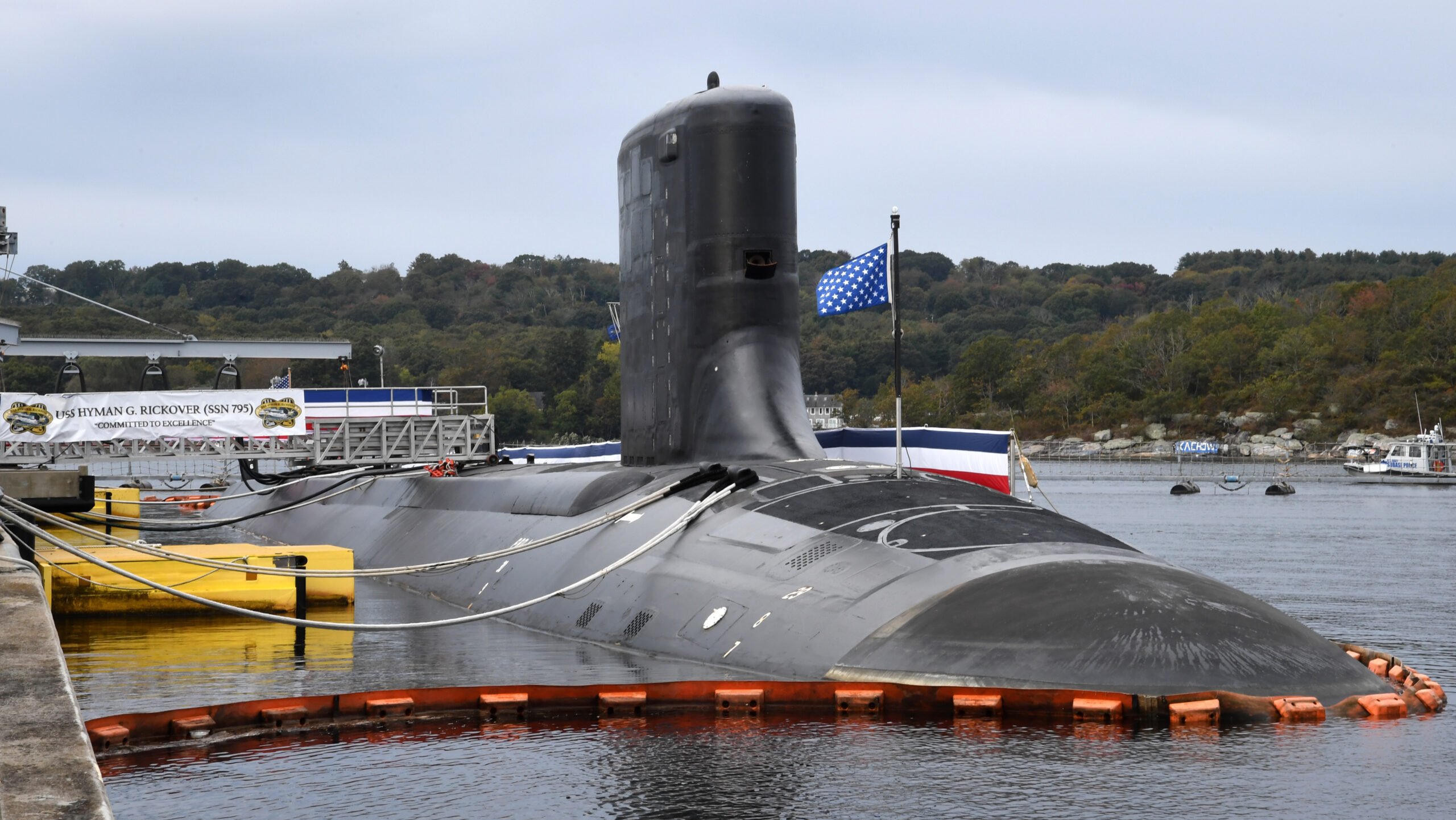
The former USS Enterprise (CVN-65) sits in port at Newport News Shipbuilding awaiting final dismantlement and disposal. (Justin Katz/Breaking Defense)
WASHINGTON — For more than a decade, the US Navy has considered the former Enterprise (CVN-65) no longer operational. In fact, since 2018, the 1,101-foot behemoth has been mostly floating pier side in Newport News, Va., awaiting final dismantlement and disposal.
Ships come and go in the Navy, but their disposal is not usually such a prolonged and complicated affair. They can be used as target practice for what the Navy calls a “SINKEX” or handed over to scrapping and salvaging companies, among other options.
But for a host of reasons, those routes are non-starters for the service’s first nuclear-powered aircraft carrier. Instead, after studying the problem for years, the service has finally settled on a path forward: enlisting commercial industry for a job it has historically done itself, and likely creating a new norm for how all nuclear-powered carriers will be disposed of going forward.
To lead that charge, Breaking Defense has learned the Navy has set up a new office just to focus on the inactivation and disposal of nuclear-powered aircraft carriers. While a spokesman declined to comment on the status of the new office, the Navy believes its decision will save millions of dollars, years of man-hours in labor and crucially, precious dock space at the public shipyards.
RELATED: Ninth Of Its Name: HII, Navy Lays The Keel For Next Enterprise
Whatever the service ends up doing, both analysts and the Navy have said it will likely set precedents for future carriers facing disposal, and the clock is ticking. The longer it takes, the more likely it is the Pentagon will risk a buildup of older carriers taking up various private and public ports around the country.
Even if everything goes according to the Navy’s preliminary plans, time is not on the service’s side. Public Navy documents show that Enterprise will not begin dismantlement until 2025, and the work will continue through 2029 — meaning even if everything stays on track, the work will be ongoing when the second nuclear-powered aircraft carrier, USS Nimitz (CVN-68), is scheduled to leave the operational fleet in 2026. The USS Eisenhower (CVN-69) will follow suit not long after.
“The Navy has really had a tough time figuring out … what’s the process we’d go about dismantling this thing,” said Bryan Clark, a fellow at the Hudson Institute and retired submariner. “That’s why the Enterprise in particular has been sitting around waiting to be dismantled. And we’re going to have the same problem with the Nimitz.”
‘A Lot Easier With Submarines’
The Navy is not going into this process blind. It has decades of experience rendering nuclear-powered submarines and cruisers safe. Since 1986, the service has disposed of 142 reactor compartment packages, according to Navy spokesman Alan Baribeau.
The traditional process for disposing of a nuclear-powered sub begins with defueling the boat and towing it to Puget Sound Naval Shipyard in Bremerton, Wash., where workers cut out the section of the ship containing the propulsion plants. The spent fuel, reactors and reactor compartments are packaged and sent to various Department of Energy facilities, which specialize in long-term storage and disposal of nuclear materials, in the Pacific Northwest.
“That was a lot easier with submarines and cruisers,” said Steven Wills, an analyst at the Center for Maritime Strategy. “These [carriers] take up too much space and affect operational units that are based in Bremerton.”
Compared to modern submarines that house just one reactor, Enterprise has eight, a remnant of the early stages of nuclear technology when construction began in 1958. The Nimitz-class, which the service started building in the 1960s, has two reactors per ship. (Baribeau noted that the design differences between Enterprise, the Nimitz and Ford-class carriers will be taken into consideration when the latter classes are prepared for disposal, but added that “lessons learned” from Enterprise will inform the Navy’s choices for its successors.)

The aircraft carrier USS Nimitz (CVN 68) cruises in the Strait of Juan de Fuca. (US Navy photo by Mass Communication Specialist 2nd Class John Hetherington)
Even just finding a place to dock a carrier can be challenging. Space at one of the four public shipyards comes at a premium, which is where HII, the only American shipbuilder capable of constructing aircraft carriers, comes into play.
Following the Navy’s call in 2012 to take Enterprise out of operational service, it contracted the shipbuilding company to defuel the carrier, among a list of other tasks necessary to prepare it for dismantling, work that concluded in 2018. Still, compartments of the ship that contained nuclear materials for decades have been irradiated and would pose a risk to the environment if the service were to conduct a “SINKEX.”
Since then, the Navy’s efforts to study how to dispose of Enterprise have largely been internal. It wasn’t until 2022 that the service released its first draft of a public document, called an “environmental impact statement,” in which it laid out three possible methods for disposal: The first two methods involved Puget Sound Naval Shipyard in Washington and vary in how the reactors would be packaged and shipped off for disposal. Enlisting industry’s assistance was the third option, and the Navy made clear that was its preferred method.
In September the service ruled out disposal strategies utilizing Puget Sound in the final draft of its environmental impact statement. Although the Navy has not yet awarded a contract, the impact statement says it has evaluated potential sites in Hampton Roads, Va., Brownsville, Texas, and Mobile, Ala.
A Novel Solution To A Novel Problem
While analysts said submarines were an apt analog due to the service’s history of disposing of the boats’ nuclear reactors, the Navy has looked elsewhere for comparisons in the dismantling process of a nuclear-powered carrier.
“Notably, several civilian, land-based, nuclear power plants, which are larger and more radiologically complex than Navy aircraft carrier reactor plants, have successfully been dismantled and disposed of by the commercial nuclear services industry,” the service said in a solicitation to industry earlier this year.
Clark noted the Navy’s original nuclear propulsion programs predate the civilian nuclear energy sector, meaning it was an imperative at the time for the Pentagon to have the expertise in-house to see the technology’s lifecycle through from start to finish. But, unlike when Enterprise was being built, there are now private companies capable of dismantling nuclear power plants.
“The Navy could tap into that capacity to be able to dismantle these nuclear reactors [while they’re still onboard the carrier], and dispose of the components, instead of taking the whole reactor compartment out and then disposing of the reactor compartment like we do to submarines,” he said.
Then there’s the cost.
The service estimates that using commercial industry for virtually all aspects of the dismantlement and disposal will run it between $554 and $696 million, according to the environmental impact statement. By comparison, the two alternatives involving the public shipyards have price tags ranging from $1.1 billion to $1.4 billion. The impact statement also says the commercial option will only take five years while the public shipyards would require 15 years or more to complete the job.
However, those estimates are in fiscal year 2019 dollars and are not adjusted for inflation, meaning the true costs of dismantling Enterprise, which is slated to begin in 2025, will almost certainly be higher.
Alternatively, storing the carrier indefinitely would run the Pentagon $10 million per year, according to the impact statement. It’s not clear how much of that money accounts for renting pier space at a private shipyard such as HII’s Newport News, but it does give a glimpse into how much keeping the ship in the water is costing the Defense Department annually.
Finally, by using commercial industry, the Navy hopes it will free up space at the public shipyards, which are already overburdened with the demands of maintaining the Navy’s current fleet.
Baribeau, the Navy spokesperson, added that if the service were to use Puget Sound for the disposal work, it would require infrastructure modifications at the Port of Benton and “improvements to the transport route” used to reach the Department of Energy’s facilities “due to the heavier weight and larger size of the dual reactor compartment packages.”
The commercial route will “reduce the Navy inactive ship inventory, eliminate costs associated with maintaining the ship in a safe stowage condition, and dispose of legacy radiological and hazardous wastes in an environmentally responsible manner, while meeting the operational needs of the Navy,” Baribeau said.
“Commercial dismantlement and disposal of ex-Enterprise supports the Navy prioritizing limited public shipyard resources on active fleet maintenance while realizing cost benefits to the U.S. taxpayer,” he continued.
Bradley Martin, a researcher at the RAND Corporation, predicted the Navy’s choice to contract with industry for Enterprise’s disposal will pay off down the road.
“I think this, if it works out, it’ll actually be a good model,” he told Breaking Defense. “The capacity of Navy shipyards to deal with everything they’re supposed to be dealing with is already pretty strained.”
The dismantlement process, he added, “takes a lot of time and effort and people.”

The Virginia-class fast attack submarine USS Hyman G. Rickover (SSN 795) is moored pier side during a commissioning ceremony at Naval Submarine Base New London in Groton, Connecticut on Oct. 14, 2023. (U.S. Navy photo by Chief Petty Officer Joshua Karsten)
The Legacy of Hyman Rickover
Hundreds of miles away from the former USS Enterprise, in Groton, Conn., the Navy in October commissioned one of its newest nuclear-powered, Virginia-class fast attack submarines. The boat is named after Adm. Hyman G. Rickover, a veritable legend in the submarine community who is credited with establishing the nuclear propulsion program that now powers much of the modern Navy’s fleet.
While the admiral was known for his strict adherence to safety protocols, Wills questioned to what extent the Navy in the late 1940s and 1950s, when Rickover was on active duty, had thought about what would occur when a nuclear vessel was no longer operationally useful.
Rickover “was a big proponent of reactor safety and safety within the operating process, but I’m not sure anybody ever got to the retirement process. You could probably argue that this is all catching up with us now,” Wills said.
“It was one thing to retire submarine reactors and smaller surface ship reactors, but aircraft carriers represent a bigger challenge,” he said.
Shipbuilder Austal USA names Michelle Kruger as new president
Kruger had been serving as interim president since former chief Rusty Murdaugh resigned last spring.



























